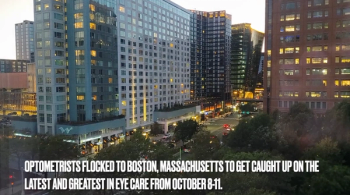
- October digital edition 2021
- Volume 13
- Issue 10
Use OCT to determine scleral lens clearance
Apply this technology to assess corneal clearance and improve fitting success
Scleral contact lenses have revolutionized the way eye care practitioners correct some of the most irregular corneas. These highly specialized lenses provide the benefit of immediate comfort for most patients in addition to vaulting over corneal irregularities—substantially improving vision for patients. New technologies have allowed practitioners to fit these lenses with more precision than ever before. One of the technologies that has revolutionized fitting accuracy is anterior segment optical coherence tomography (AS-OCT).
OCT in scleral lens fitting
AS-OCT is commonly used to estimate central corneal clearance (CCC) of the scleral lens over the cornea. CCC is one of the key components of a successful scleral lens fit. The goal of an appropriate scleral lens fit is a corneal clearance of 100 to 300 µm at the portion of the cornea where the lens comes in closest proximity to it. This becomes increasingly challenging when fitting highly irregular corneas because portions of the lens may vault the cornea at much greater levels of clearance.
AS-OCT provides precision in the fitting process that is difficult to replicate with a slit lamp estimation of CCC. Contemporary AS-OCT technologies provide the ability to view the cornea at a variety of angles. One of the most powerful features is radial scans that measure around the center of the cornea. This gives the clinician the opportunity to determine lens centration in both horizontal and vertical meridians.
Here, I review the finer points for accurately using AS-OCT scans to appropriately assess corneal clearance and employing the images to improve scleral lens fitting success.
Nonectatic corneas
Scleral lenses have been deployed for a variety of ocular surface conditions. They are indicated for nonectatic corneal conditions, including corneal dystrophy such as epithelial basement membrane dystrophy, severe keratoconjunctivitis, nonresolving epithelial erosions, corneal transplant, and Salzmann nodular degeneration, or for individuals with scarred corneas leading to irregular surfaces.
Although these corneas have irregular surfaces, they are often not ectatic. As such, the variable of irregularity is removed, creating a straightforward fitting process when looking at corneal clearance. Ideally, the cornea should be cleared at equal amounts in every meridian measured.
If asymmetries exist in the amount of clearance among the regions of the cornea, it is critical to determine the reasons. Figure 1A shows a representation of an ideal clearance in any meridian. Clinicians should look for even amounts of clearance across the scleral lens. Figure 1B demonstrates an even distribution of lens clearance over the cornea and represents a well-centered lens in the meridian viewed.
Seeing OCT scans in the horizontal meridian prompts attempts to centralize the lens as best as possible. Paying particular attention to the clearance pattern will help determine the centration of the lens on the eye. Figure 2 depicts a decentered lens. The direction of decentration can be determined by the portion of the lens-cornea relationship that hasthe largest region of clearance. If a lens is viewed on the left eye and a horizontal cross-sectional cut is viewed with an OCT, a lens that is temporarily decentered would have less clearance on the nasal aspect of the cornea and more clearance on the temporal aspect (Figure 3).
It is critical to understand the contributing factors to lens decentration. A landing zone that inappropriately fits along the sclera, too much CCC creating excessive vaulting, and a larger-diameter lens are factors that can affect centration. It is important to optimize these characteristics of a scleral lens. Ensure that the landing zone is not too flat in any meridian because this is a major contributor to lens decentration. Excessive vaulting, in addition to creating an additional oxygen barrier for the cornea, can also cause movement and decentration with the force of the lid attempting to blink over the lens. Additionally, a larger lens will often add unnecessary weight to the lens, which may cause decentration.
Just as important as assessing decentration in the horizontal meridian is assessing centration in other scanned meridians. Figure 4 demonstrates a vertical AS-OCT scan showing an inferior lens decentration. This can be seen by the great corneal clearance inferiorly than visible superiorly. This lens is decentered because the landing zone is flatter than the vertical scleral profile. This scleral lens fit would benefit from the clinician steepening the landing zone in the vertical meridian to improve the vertical decentration.
Ectatic corneas
When viewing in any cross-section the clearance profile in patients with ectatic corneas, it becomes difficult to analyze centration based on the clearance characteristics across these ectatic corneas. As seen in Figure 5, the horizontal and vertical cross sections in a patient with keratoconus can appear very different because of the inferior ectasia.
In these instances, it is critical to view the limbal clearance to attempt to obtain symmetry in the vertical meridian of patients with ectatic corneas. Interestingly, the horizontal cross-section appears normal, and similar considerations can be taken when fitting the nonectatic cornea.
An additional consideration with fitting an ectatic cornea is the ability to alter the curves of the scleral lens to better meet the needs of the underlying cornea. Contemporary scleral lens designs can incorporate zone modifications independent of other zones. As such, scleral lenses can be made more prolate for patients with ectatic corneas.
Conclusion
Understanding the power of CCC provides the clinician with an additional tool to optimize the fit of scleral lenses. Using OCT imaging provides valuable information in the appropriate fit of scleral lenses.
Articles in this issue
about 4 years ago
The future of physician waiting roomsabout 4 years ago
How to drop a vision plan and replace revenueabout 4 years ago
Beyond anxiety in patients with glaucomaabout 4 years ago
Top 9 sports vision resourcesabout 4 years ago
Demodex: Recognize it and treat itabout 4 years ago
Approach patients with low vision on an individual basisabout 4 years ago
Central serous retinopathy is not a benign diseaseover 4 years ago
Delta COVID-19 variant forcing meeting changesNewsletter
Want more insights like this? Subscribe to Optometry Times and get clinical pearls and practice tips delivered straight to your inbox.













































